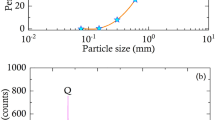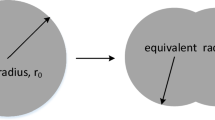Abstract
This paper presents a composite particle model with sphere clumps for modelling non-spherical particles in discrete element method (DEM) simulations. The formulation of the sphere clumps uses random selections of particle radii and positions, thus it can theoretically simulate all possible non-spherical particles encountered in engineering projects. In this study, the generation of sphere clumps in space was discussed in detail, and different particle non-sphericities were compared. This numerical model has been employed to study the shear behaviour of granular assemblies under undrained triaxial compression conditions. It is evident that the use of composite particle model in the DEM can largely increase the shear strengths of granular assemblies. For granular samples consisting of various types of sphere clumps, different mechanical responses have been observed. In particular, the sphere clumps with high non-sphericity can lead to very high peak/residual shear strength, and high material internal friction angle. The use of sphere clumps mixture can modulate the shear behaviour, with its mechanical properties being close to those of real quartz sand grains.











Similar content being viewed by others
References
Rowe, P.W.: The stress-dilatancy relation for static equilibrium of an assembly of particles in contact. Proc. R. Soc. Lond. Series A Math. Phys. Sci. 269(1339), 500–527 (1962)
Terzaghi, K., Peck, R.B., Mesri, G.: Soil Mechanics in Engineering Practice. Wiley, London (1996)
Barrett, P.J.: The shape of rock particles, a critical review. Sedimentology 27(3), 291–303 (1980)
Muhlhaus, H.B., Vardoulakis, I.: The thickness of shear bands in granular materials. Geotechnique 37(3), 271–283 (1987)
Jiang, M.J., Yu, H.S., Harris, D.: A novel discrete model for granular material incorporating rolling resistance. Comput. Geotech. 32(5), 340–357 (2005)
Cundall, P.A., Strack, O.D.L.: A discrete numerical model for granular assemblies. Geotechnique 29(1), 47–65 (1979)
Bardet, J.P., Proubet, J.: A numerical investigation of the structure of persistent shear bands in granular media. Geotechnique 41(4), 599–613 (1991)
Ting, J.M., Corkum, B.T., Kauffman, C.R., Greco, C.: Discrete numerical-model for soil mechanics. J. Geotechn. Eng. ASCE. 115(3), 379–398 (1989)
Rothenburg, L., Bathurst, R.J.: Micromechanical features of granular assemblies with planar elliptical particles. Geotechnique 42(1), 79–95 (1992)
Thornton, C.: Numerical simulations of deviatoric shear deformation of granular media. Geotechnique 50(1), 43–53 (2000)
Oda, M., Konishi, J., Nemat-Nasser, S.: Experimental micromechanical evaluation of strength of granular materials: effects of particle rolling. Mech Mater 1(4), 269–283 (1982)
Oda, M., Kazama, H.: Micro-structure of shear band and its relation to the mechanism of dilatancy and failure of granular soils. Geotechnique 48(4), 465–481 (1998)
Belheine, N., Plassiard, J.P., Donzé, F.V., Darve, F., Seridi, A.: Numerical simulation of drained triaxial test using 3D discrete element modeling. Comput. Geotech. 36(1–2), 320–331 (2009)
Houlsby, G.T.: Potential particles: a method for modelling non-circular particles in DEM. Comput. Geotech. 36(6), 953–959 (2009)
Boon, C.W., Houlsby, G.T., Utili, S.: A new contact detection algorithm for three-dimensional non-spherical particles. Powder Technol. 248, 94–102 (2013)
Williams, K.C., Chen, W., Weeger, S., Donohue, T.J.: Particle shape characterisation and its application to discrete element modelling. Particuology 12, 80–89 (2014)
Iwashita, K., Oda, M.: Rolling resistance at contacts in simulation of shear band development by DEM. J. Eng. Mech. ASCE. 124(3), 285–292 (1998)
Ferellec, J.-F., McDowell, G.: A method to model realistic particle shape and inertia in DEM. Granul. Matter 12(5), 459–467 (2010)
Ma, G., Zhou, W., Chang, X.L., Yuan, W.: Combined FEM/DEM modeling of triaxial compression tests for rockfills with polyhedral particles. Int. J. Geomech. 14(4), 1–12 (2014)
Wachs, A., Girolami, L., Vinay, G., Ferrer, G.: Grains3D, a flexible DEM approach for particles of arbitrary convex shape—Part I: numerical model and validations. Powder Technol. 224, 374–389 (2012)
Boon, C.W., Houlsby, G.T., Utili, S.: A new algorithm for contact detection between convex polygonal and polyhedral particles in the discrete element method. Comput. Geotech. 44, 73–82 (2012)
Wensrich, C.M., Katterfeld, A.: Rolling friction as a technique for modelling particle shape in DEM. Powder Technol. 217, 409–417 (2012)
de Bono, J.P., McDowell, G.R.: An insight into the yielding and normal compression of sand with irregularly-shaped particles using DEM. Powder Technol. 271, 270–277 (2015)
Lu, G., Third, J.R., Müller, C.R.: Discrete element models for non-spherical particle systems: From theoretical developments to applications. ChEnS. 127, 425–465 (2015)
Dong, K., Wang, C., Yu, A.: A novel method based on orientation discretization for discrete element modeling of non-spherical particles. ChEnS. 126, 500–516 (2015)
Guises, R., Xiang, J., Latham, J.-P., Munjiza, A.: Granular packing: numerical simulation and the characterisation of the effect of particle shape. Granul. Matter. 11(5), 281–292 (2009)
Jia, X., Gan, M., Williams, R.A., Rhodes, D.: Validation of a digital packing algorithm in predicting powder packing densities. Powder Technol. 174(1–2), 10–13 (2007)
Zhao, X.L., Evans, T.M.: Numerical analysis of critical state behaviors of granular soils under different loading conditions. Granul. Matter. 13(6), 751–764 (2011)
Bardet, J.P.: Observations on the effects of particle rotations on the failure of idealized granular-materials. Mech. Mater. 18(2), 159–182 (1994)
Shigeto, Y., Sakai, M.: Parallel computing of discrete element method on multi-core processors. Particuology 9(4), 398–405 (2011)
Chen, F., Ge, W., Guo, L., He, X., Li, B., Li, J., et al.: Multi-scale HPC system for multi-scale discrete simulation—development and application of a supercomputer with 1 Petaflops peak performance in single precision. Particuology 7(4), 332–335 (2009)
Fraige, F.Y., Langston, P.A., Chen, G.Z.: Distinct element modelling of cubic particle packing and flow. Powder Technol. 186(3), 224–240 (2008)
Kodam, M., Bharadwaj, R., Curtis, J., Hancock, B., Wassgren, C.: Cylindrical object contact detection for use in discrete element method simulations, Part II–experimental validation. ChEnS 65(22), 5863–5871 (2010)
Langston, P.A., Al-Awamleh, M.A., Fraige, F.Y., Asmar, B.N.: Distinct element modelling of non-spherical frictionless particle flow. ChEnS 59(2), 425–435 (2004)
Abe, S., Place, D., Mora, P.: A parallel implementation of the lattice solid model for the simulation of rock mechanics and earthquake dynamics. Pure Appl. Geophys. 161(11–12), 2265–2277 (2004)
Utili, S., Zhao, T., Houlsby, G.T.: 3D DEM investigation of granular column collapse: evaluation of debris motion and its destructive power. Eng. Geol. 186, 3–16 (2015)
Damasceno, P.F., Engel, M., Glotzer, S.C.: Predictive self-assembly of polyhedra into complex structures. Science 337(6093), 453–457 (2012)
Fang, H.-Y.: Foundation Engineering Handbook. CBS Publishers & Distributors, New Delhi (1991)
Huang, W.X., Sun, D.A., Sloan, S.W.: Analysis of the failure mode and softening behaviour of sands in true triaxial tests. Int. J. Solids Struct. 44(5), 1423–1437 (2007)
Casagli, N., Ermini, L., Rosati, G.: Determining grain size distribution of the material composing landslide dams in the Northern Apennines: sampling and processing methods. Eng. Geol. 69(1–2), 83–97 (2003)
Crosta, G.B., Frattini, P., Fusi, N.: Fragmentation in the Val Pola rock avalanche, Italian Alps. J. Geophys. Res. Earth Surf. 112(F1), F01006 (2007)
Lee, S.J., Hashash, Y.M.A., Nezami, E.G.: Simulation of triaxial compression tests with polyhedral discrete elements. Comput. Geotech. 43, 92–100 (2012)
Modenese, C.: Numerical Study of the Mechanical Properties of Lunar Soil by the Discrete Element Method. D.Phil Thesis: University of Oxford (2013)
Thornton, C., Antony, S.J.: Quasi-static deformation of particulate media. Philos. Trans. R. Soc. Lond. Series A Math. Phys. Eng. Sci. 356(1747), 2763–2782 (1998)
Praastrup, U., Jakobsen, K.P., Ibsen, L.B.: Two theoretically consistent methods for analysing triaxial tests. Comput. Geotech. 25(3), 157–170 (1999)
Iwashita, K.: Rolling resistance at contacts in simulation of shear band development by DEM. J. Eng. Mech. 124(285), 285–292 (1998)
Lube, G., Huppert, H.E., Sparks, R.S., Freundt, A.: Collapses of two-dimensional granular columns. Phys. Rev. E. 72, 1–10 (2005)
Acknowledgments
This work is supported by the research grant from the ‘Program of Young Scholars from Renowned Universities or Institutes’ at Sichuan University, National Program on Key basic Research Project (No. 2015CB057903), National Natural Science Foundation of China (No. 51374149), Program for New Century Excellent Talents in University (NCET-13-0382) and the Youth Science and Technology Fund of Sichuan Province (2014JQ0004).
Author information
Authors and Affiliations
Corresponding author
Additional information
T. Zhao was formerly at the Department of Engineering Science, University of Oxford, Oxford, OX1 3PJ, UK.
Rights and permissions
About this article
Cite this article
Zhao, T., Dai, F., Xu, N.W. et al. A composite particle model for non-spherical particles in DEM simulations. Granular Matter 17, 763–774 (2015). https://doi.org/10.1007/s10035-015-0596-7
Received:
Published:
Issue Date:
DOI: https://doi.org/10.1007/s10035-015-0596-7




